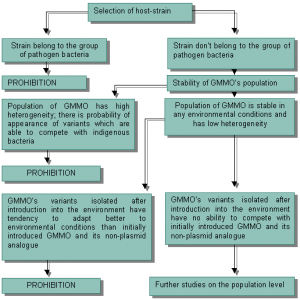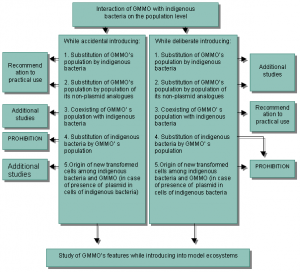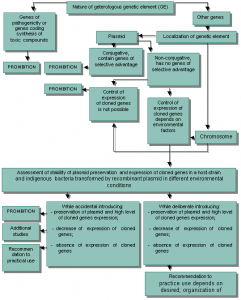Institute of Biophysics, SB RAS, Krasnoyarsk
Head of the Institute:
Andrey G.Degermendzhy, Doctor of Physical and Mathematics Sciences
Akademgorodok, Krasnoyarsk, 660036, Russia
Phone: (3912) 431579
Fax: (3912) 433400
email: ibp@ibp.krasnoyarsk.su
Principal researchers:
N.S.Pechurkin, Doctor of Biological Sciences, Professor
L.Y.Popova, Ph.D. (Biology), senior researcher
A.V.Brilíkov, Doctor of Biological Sciences, leading researcher
Project objectives
Risk assessment of genetical pollution of the environment and of the breach of natural biodiversity.
Background and significance of objectives
One of the most important and complex problems of microbial and molecular ecology is associated with the risk assessment of the release of recombinant DNA carriers into the environment. The incidence of genetically modified microorganisms (GMMO) in the environment may lead to unpredictable results. In the first place, to changes in the microbial composition of natural ecosystems (from the death of the GMMO population to its coexistence with aboriginal microorganisms or even complete domination). Therefore, misbalance in the biogenic cycle, the breach of biocoenosis and a reduction in biological diversity may take place not only at the level of micro- but even of macroorganisms. On the other hand, there are frequently genes in recombinant plasmids, products of which may influence the structure and characteristics of the microbial association of the ecosystem. When such plasmids migrate into the cells of the dominant microorganisms of ecosystems, their characteristics will firmly hold in the natural habitat or can be found in other ecosystems. Over the past 10 years research into the stability of recombinant plasmids with lux-genes, cloned as a marker-genes, has been carried out under various conditions in the Laboratory of Heterotroph Biosynthesis Control of IBP SB RAS. After introduction into the aquatic microecosystems of a different organisation, qualitative changes in Escherichia coli Z905 (AprLux+) population were revealed. The basic factors of aquatic ecosystems that influence the GMMO population structure were determined. The changes in the expression of the cloned lux-genes in the cells of introduced E.coli strain Z905 depend not only on the plasmid copy number but also on whether the cells are able to change metabolic activity regulation. The mechanisms controlling the level of cloned lux-genes expression in some aboriginal microorganisms that received recombinant plasmid pPHL7 with cloned lux-genes, were studied. Applied direction of the project caused by a great number of recombinant probiotics and live vaccines prepared for use in medicine and agriculture. Thus, we study Bacillus subtilis 2335/105 recombinant strain, which is part of the medical preparation subalin. It is necessary to maintain the activity of the preparation (the production of cloned in plasmid genes of human a2-interferon during treatment of animals and men). On the other hand, it is preferable that its activity be decreased in natural ecosystems. It is of special importance that a good marker be used in the recombinant plasmid because of the DNA-ability to maintain in the natural ecosystems, specifically in soil, rather long and besides the ability to transfer retain. Using lux-genes as markers meets the requirements. Also we have experience in studying the plasmid profile of microflora and in assessing the functional load of plasmid genes. During 3 years we have investigated the expansion of osmotolerance and multiple antibiotic resistance among dominant groups of microorganisms depending on their habitation (far and not far from the health resort) and on the season. Such field studies allow one to determine the antropogenic (according to gradient of multiple antibiotic resistance) and natural (according to osmotolerance) load on the lake microflora. The theoretical approach based on the constructing of the distributed models of the dynamics of the GMMO population and systemís modelling of trophic chains dynamics in model ecosystems is worked out.
Research plan: approaches and methods
The essential distinction of our research is the complex approach with the assessment of GMMO adaptation at different hierarchy levels. Qualitative and quantitative analyses of recombinant plasmid of GMMO variants and aboriginal microflora, isolated from microcosms will be carried out with the aid of up-to-date techniques of molecular ecology including DNA-hybridization and polymerase chain reaction (PCR). The studying of the processes of migration of GMMO, recombinant and natural plasmids in the model ecosystem of various types gives hope for a complex solution of the problem of working out of passports for GMMO, scheduled for release, and microbiological mapping of important natural ecosystems on a good experimental and theoretical base comparable to the world’s level and even passing ahead both home and foreign developments in this scientific direction. Timely development of monitoring methods and services must provide ecological safety of new biotechnologies, which will be intensively developed in the XXI century. Having got negative experience of environment pollution with chemicals that have been widely used in agriculture, industry and medicine, mankind should take all possible measures to preserve the clearance and biological diversity of natural ecosystems (including animals, plants and man).
Expected results
The investigation of GMMO survival and adaptation in microcosms of various organisation will be carried out. The risk of migration of recombinant plasmids among aboriginal microorganisms of different natural habitats in microcosm conditions will be estimated. The risk assessment of transfer of natural plasmids to GMMO cells will be carried out. The multiple antibiotic resistance spreading among aboriginal microorganisms in natural ecosystems will be studied in the case of lakes of Khakasia. The schemes of stage-by-stage monitoring of recombinant DNA with the marker lux-genes use and PCR for human a2-interferon genes will be worked out.
List of publications of participants related to the project
-
Brilíkov A.V., Popova L.Yu., Baranova E.A., Maksimova E.E., Repeta T.V., Pechurkin N.S. The prognosal investigation of survival and expansion of GEM in laboratory aquatic ecosystems // Droc. RAN. ñ 1995. ñ Vol. 341, π 3. ñ P. 429-430. (In Russin).
-
Kargatova T.V., Maksimova E.E., Popova L.Yu., Brilíkov A.V., Pechurkin N.S. Phenotipical variability of the population of the recombinant luminescent Escherichia coli strain in aquatic microcosms // Microbiology. ñ 1997. ñ Vol. 66, No 1. ñ P. 101-106. (In Russian).
-
Pechurkin N.S. Popova L.Yu., Kargatova T.V., Maksimova E.E. To the risk assessment of uncontrolled development of GMMO in the environment (Methodological approach) // Siberian G. Ecological. ñ 1997. ñ π 5. ñ —. 447-452. (In Russian).
-
Popova L.Yu., Kargatova T.V., Maksimova E.E., Belyavskaya V.A. Adaptation of Bacillus subtilis strain, contained recombinant plasmid with the human interferon-a2 genes, to different conditions// Microbiology. ñ 1997. ñ Vol. 66, π 6. ñ P. 761-766. (In Russian).
-
Maksimova E.E., Popova L.Yu. The changing of regulation of lux-operon, cloned in the recombinant plasmid in Escherichia coli cells, during consecutive generations in different conditions of cultivation // Molecular Biology. ñ 1998. ñ Vol. 32, π 2. ñ P. 371-372. (In Russian).
-
Maksimova E.E., Popova L.Yu., Shpagina V.V., Belyavskaya V.A., Pechurkin N.S. The changing of the regulation of the catabolite-depending lux-operone cloned in recombinant plasmid under the influence of the environmental factors // Microbiology. ñ 1998. ñ Vol. 67, π 20. ñ P. 170-175. (In Russian).
-
Popova L.Yu., Maksimova E.E., Kargatova T.V., Brilíkov A.V., Pechurkin N.S. Introduction and the long-term survival of recombinant luminescent Escherichia coli Z905 strain in laboratory aquatic microecosystems // Trans. RAS. Biol. series. ñ 1998. ñ π 5. ñ P. 609-616.
STUDY OF GMMOíS FEATURES ON THE CELL LEVEL
STUDY OF GMMOíS FEATURES ON THE ECOSYSTEM LEVEL
STUDY OF GMMO’S FEATURES ON THE POPULATION LEVEL
STUDY OF GMMOíS FEATURES ON THE MOLECULAR LEVEL




